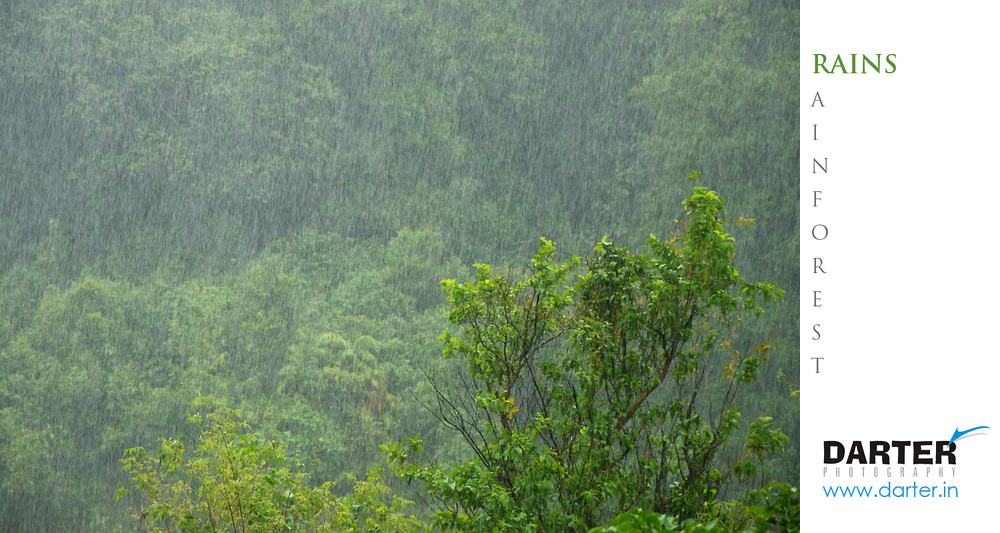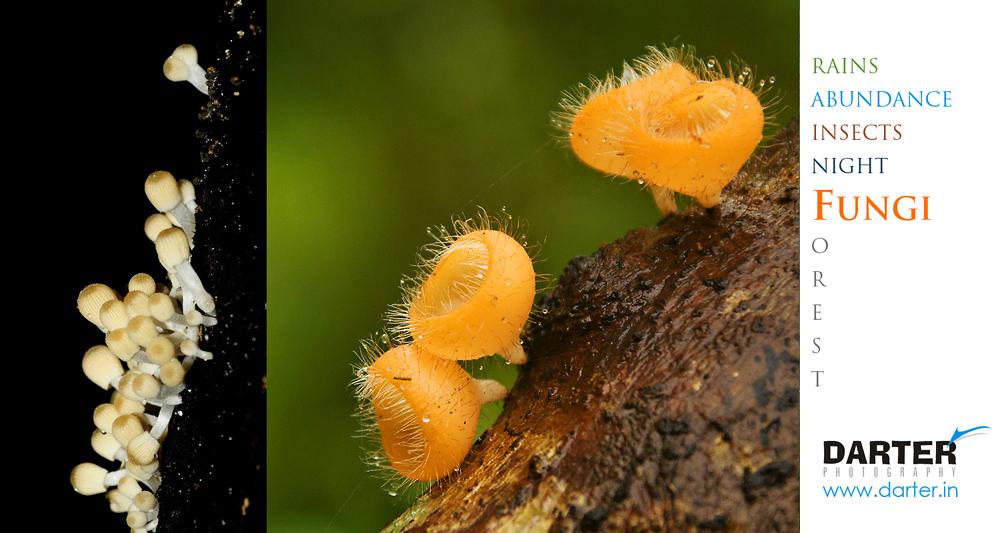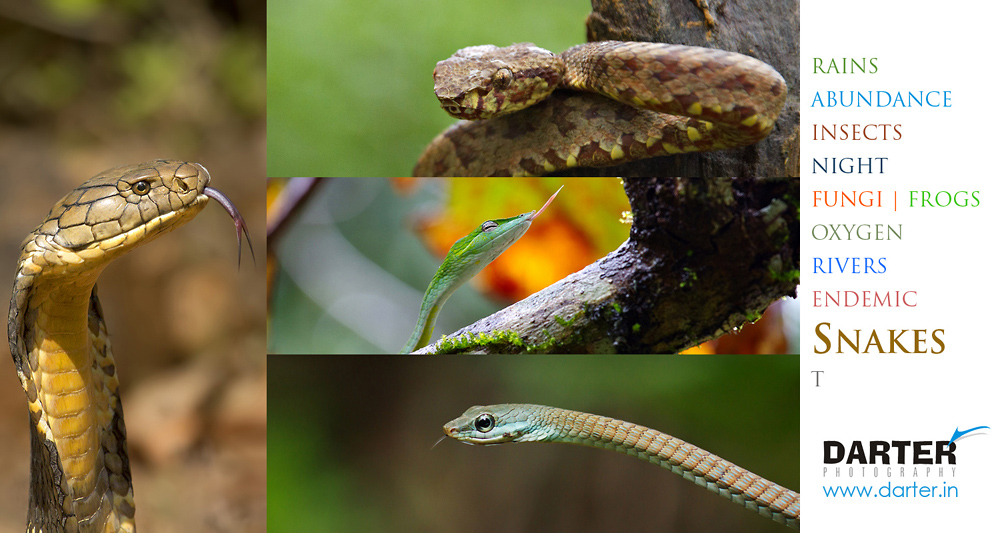A few weeks back, we ran a hugely successful campaign about Rainforests on our Rainforest Rendezvous with Darter Photography page. This blog post summarizes the entire campaign.
What is a Rainforest? How is it different from other forests? What is the experience like? What does one get to see in the Rainforest? These are some of the questions that come up often when we talk about our Rainforest Rendezvous tours. To answer some of these questions and to provide a glimpse into the enigma that are Rainforests, we came up with a campaign – Decoding the RAINFOREST. The idea is simple – we expand each letter of the word RAINFOREST into words that bring out the essence of these magical places. Here we go..starting with R!
R for RAINS
That was fairly straighforward! High rainfall defines rainforests, with a minimum annual rainfall of 1750-2000mm. The rainfall can be spread through the year (as in the Equatorial Rainforests) or occur seasonally (as in the Monsoon forests of the Western Ghats). Places like Agumbe in the Western Ghats have received rainfall in excess of 9000mm in some years.
A for ABUNDANCE
The sheer amount and diversity of life in the rainforest is remarkable. With every step in the rainforest, one comes across something interesting – be it an insect or a flower or a fungus. Consider this – rainforests support more than 50% of flora and fauna species on Earth despite occupying less than 6% (and decreasing) of the land area.
Many species, however, are not very numerous in their populations. Also, they tend to be fairly localized making them threatened by human-induced changes like climate change and degrading/reducing habitat.
I for INSECTS
Insects are everywhere in the rainforest. Whether it be day or night, on the ground or on the trees (even on water!), they offer some amazing photography opportunities.
Insects are very important to the rainforest eco-system. In addition to being part of the food chain, they perform crucial roles as pollinators and scavengers.
N for NIGHT
The silence of the night in the rainforest is so peaceful. Punctuated by the chirping of crickets and the croaking of frogs, you have to be there to experience bliss!
Our night walks around the camp site at Agumbe have been very popular amongs participants. May be it’s the suspense. May be it’s the feel of the rainforest. May be it’s the joy of discovery…
F for FUNGI
You cannot miss Fungi in a rainforest. Coming in all shapes, colours and sizes, fungi play the very important role of recycling nutrients in the rainforest from plant and animal matter.
F (again) for FROGS
Come monsoons, the rainforest comes alive with the symphony of frogs. Their croaking and clicking, as they look for potential mates, fills the air whether it be day or night.
Amphibians, including many species of frogs, are threatened globally due to climate change, habitat loss and fungal infections (the ominous side of Fungi).
O for OXYGEN
Rainforests are responsible for 28% of the world’s Oxygen turnover. They provide this very essential environmental service by recycling Carbon Dioxide into Oxygen through photosynthesis.
No wonder they have been called the Lungs of the World.
R (the second one) for RIVERS
The heavy rainfall in the rainforests results in streams and rivulets everywhere. Some of these eventually merge into some of the greatest rivers in the world, including the Amazon and the Congo.
Closer home, the Western Ghats form an important water shed area for some of peninsular India’s largest rivers like Godavari, Krishna, Kaveri and Tungabhadra.
E for ENDEMIC
Endemism is the ecological state of being unique to a defined geographic location (Source: Wikipedia). The rainforests of Western Ghats have many endemic species of flora and fauna. As many as 80% of the amphibian species found here are endemic to the region. 16 species of birds are also found nowhere else in the world.
Many of the endemic species are also endangered due to shrinking habitat, changing climate and other factors.
S for SNAKES
There are more species of snakes found in rainforests than any other habitat around the world. Snakes thrive in rainforests as these habitats offer them warm temperatures, coupled with shade, humidity and cover.
Some snakes, such as the King Cobra and the Malabar Pit Viper, use venom to kill and digest their prey. Others, like the Bronzeback Tree Snake and the Beddome’s Keelback, grab their prey and swallow it. Some snakes, like the Pythons, constrict their prey before feeding on them.
Venom in snakes has evolved as a feeding strategy, but it can also be used in self-defense. Many venomous snakes, however, would choose to warn – either by hissing loudly or spreading their hood, etc. – before striking in order to save precious venom.
T for TREES
Some of the tallest trees in the world grow in rainforests. From the top, the canopy of the rainforest is almost fully covered with these magnificent trees. To support themselves, they often grown huge buttress roots.
In addition to towering trees, rainforest offer a wide variety of fauna – from creepers that use trees as support to reach to the top of the canopy to parasites that steal nutrients from the parent tree to ferns that reproduce by spreading spores.
The Rainforest can be divided into 4 broad layers, depending upon the vegetation and the height from ground.
- Emergent: The tallest trees in the rainforest occupy this layer, braving the heat of the sun and strong winds.
- Canopy: The canopy virtually covers the rainforest from the top, allowing little light from the sun to pass through. While trees with strong buttress roots occupy a large part of the canopy, creepers and epiphytes contribute to a substantial part.
- Understory: Here, the next generation of trees as well as smaller shrubs survive. The understory is not very dense due to the limited amount of light coming through the canopy. However, where there is a break in the canopy (over streams or when a tree falls), the understory layer can be very dense.
- Forest Floor: Very little sunlight (as low as 2%) penetrates to the dark and damp forest floor. The decaying organic matter here supports many organisms like insects and other fauna, and fungi.
So there we are. The RAINFOREST decoded from R to T. Of course, there’s a lot more to the Rainforests than the above descriptions. Every journey there is a process of discovery and learning.
This monsoon, Darter Photography takes you on Rainforest Rendezvous tours to Agumbe, Coorg and Goa. To learn more about these tours, click on the names of the places or visit our Wildlife Photography Tours page.











